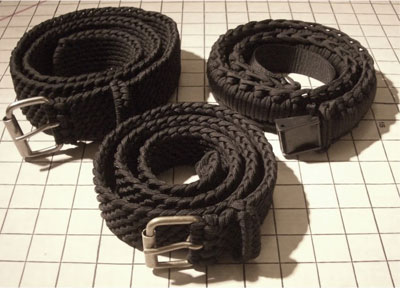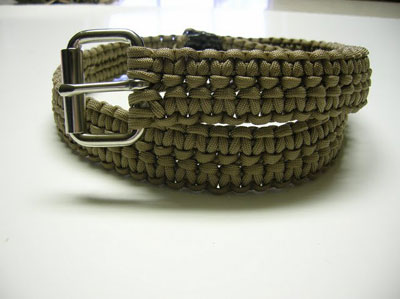Results 1,151 to 1,160 of 8447
Thread Information
Users Browsing this Thread
There are currently 14 users browsing this thread. (1 members and 13 guests)
-
07-29-2011, 01:15 AM #1151Senior Member


- Join Date
- May 2007
- Location
- South West Florida (Behind friendly lines but still in Occupied Territory)
- Posts
- 117,696
Homemade Paracord Belt
by Tactical Intelligence
September 25th, 2009
In my article on how to make a survival kit I point out the importance of having certain items with you at all times (your first tier gear) which are ideally directly on your person. One of those items that I recommend is some amount of cordage — the more the better.
For example, I always have around 10 feet of paracord in the form of a bracelet on me. Being that it’s 550 paracord, it is made up of seven separate inner fibers and one outer sheath which can be used for many survival purposes (simple lashings, snares, bowdrill string, Paiute deadfall etc).
While 10 feet is good, what if it were possible to carry around 100 feet of cordage with you at all times that is just as unassuming as a bracelet and is available to access at a moments notice? Well you can…with a paracord belt. One of our readers (Dan) provided me a link that teaches you how to make your own paracord belt — so I went off and made one. Here are some of the pictures of that process:
Buckle from an old belt

The Weave

Finished Belt

Now for you women out there that don’t necessarily wear large belts, you could easily substitute your purse strap with paracord (Prada should really come out with a paracord option).
Here are some other belts which have been made (images link to the source site).


So check it out. Since I like to push self-reliance, make one if you can. If you can’t then purchase one. Here are some resources I found on the web:
Paracord Belt Instructions
- (Update: December 7, 2010)
- Slatt’s Rescue Belt – This is an upgraded Paracord Belt that I made using the Slatt’s Rescue stitch. It looks much nicer than the above weaved belt, is easier to unravel and it stores around 120 feet of cord!
- M4040′s Blog – This is the instructions I followed to make the belt you see in the pictures above.
- Flat Braid Method – You can use this method to create a paracord belt.
- The Chubby Survivalist – Nice looking belt with some easy to follow instructions.
Other Resources
- Stormdrane’s Blog – Amazing things that you can do with paracord and knots in general. Very inspirational work.
- Animated Knotes – A great resource into many different kinds of knots (many of which can be used to make paracord gear).
Red 550 Paracord Free S/H
Valentine Paracord Kits- $4.50 & up Red Side Release Buckles 25/$10.00
www.bucklerunner.com
http://www.tacticalintelligence.net/...acord-belt.htmLast edited by AirborneSapper7; 02-02-2012 at 08:00 AM.
Join our efforts to Secure America's Borders and End Illegal Immigration by Joining ALIPAC's E-Mail Alerts network (CLICK HERE)
-
07-29-2011, 01:44 AM #1152Senior Member


- Join Date
- May 2007
- Location
- South West Florida (Behind friendly lines but still in Occupied Territory)
- Posts
- 117,696
Video: Paracord Chain Sinnet Fast Deployment Boonie Hatband
http://www.youtube.com/watch?v=mJ1g7peM ... r_embedded
Jul 8, 2011
More knotty stuff on my blog: http://stormdrane.blogspot.com
This video shows how to add 20 feet of paracord to a boonie hat using a chain sinnet, that can be quickly removed should the paracord be needed.Last edited by AirborneSapper7; 02-02-2012 at 08:02 AM.
Join our efforts to Secure America's Borders and End Illegal Immigration by Joining ALIPAC's E-Mail Alerts network (CLICK HERE)
-
07-29-2011, 01:47 AM #1153Senior Member


- Join Date
- May 2007
- Location
- South West Florida (Behind friendly lines but still in Occupied Territory)
- Posts
- 117,696
Paracord Chain Sinnet Quick Deployment Boonie Hatband

http://stormdrane.blogspot.com/2011/07/ ... yment.htmlLast edited by AirborneSapper7; 02-02-2012 at 08:02 AM.
Join our efforts to Secure America's Borders and End Illegal Immigration by Joining ALIPAC's E-Mail Alerts network (CLICK HERE)
-
07-29-2011, 01:51 AM #1154Senior Member


- Join Date
- May 2007
- Location
- South West Florida (Behind friendly lines but still in Occupied Territory)
- Posts
- 117,696
Stormdrane's Blog
Welcome to my blog. Here I've posted photos of my hobby and share some ideas on things I've learned to make using decorative and useful knots. If you want to learn, there are informative links throughout the blog for books and online learning resources. If you have trouble figuring a knot out, have patience and keep trying. Click 'Older Posts' at the bottom of the last post on each page or search the 'Archive' for more.
Links worth a visit, in mostly alphabetical order:
- * Strength for Service
- * Animated Knots by Grog
- * Andy's World of Knots
- * A.G. Russell Knives
- * American Diabetes Association
- * American Knife & Tool Institute (AKTI)
- * Astronomy Picture of the Day
- * Atwood Rope MFG
- * Absaroka Western Designs
- * ball bearings - ToolSupply
- * Barry Brown
- * berkeley point
- * Bladeforums
- * BladeOps
- * BLADEREVIEWS.com
- * Blood Sugar 101
- * Blue Smoke and BBQ
- * Books on knots...
- * BoondoggleMan.com
- * Bound_For_Cory
- * CandlePower Forums
- * Cardshark's Crafts
- * Celtic Button Knot
- * Chinese Knotting
- * Colby Knot and Tool
- * ComLax Crosslace cord
- * Congress.org
- * Constrictor knot
- * Cool Glow Stuff!
- * County Comm
- * Crazy4 Money Clips
- * creative and decorative ropework by Nick Hill
- * Creative Designworks - side release buckles - snap hooks - swivel clips
- * Cultura Marinara
- * CUrchin Knot
- * deano42
- * Des Pawson
- * devilchasnme
- * DIY TACTICAL
- * donb knots
- * DudeCraft
- * Duluth Trading Co.
- * EarthSky
- * EDC Depot
- * EDC Forums - Every Day Carry
- * Emergency Essentials
- * Enchanting Beads
- * Everyday Carry
- * Felinevet on EDC Source
- * FireSteel.com
- * Fix My Blinds - small diameter cord for knot work
- * Flashlight News
- * Flickr photo slideshow
- * Folsom's Knots
- * Frayed Knot Arts
- * FullContactGEEK
- * Fusion Knots Forum
- * Going Gear
- * Going Prepared Forum
- * GPJ Rope - mini blind cord
- * Grant Cunningham
- * Gun & Game
- * Hand-Crafted Knot Jewelry
- * Home On the Range
- * HORAN KNIVES
- * Ian's Shoelace Site
- * Innovative Ropework
- * instructables
- * International Guild of Knot Tyers
- * It's Knot Art
- * ITW Nexus
- * JerzeeDevil Forums
- * Joe's Knots
- * Ken's chain sinnet paracord bracelet tutorial
- * Knives and Lanyards
- * knoopenzo
- * Knot Heads World Wide
- * Knotical's Blog
- * Knots on the Web
- * knottool.com
- * Knotty Sean
- * knotworkn
- * Ladder Rack Knot
- * Leatherworker.net
- * Lighthound
- * LoopyLacer's Knot-Tying and Tatting Blog
- * Machine woven parachute cord braided belts
- * Make a rope rug
- * Making Rope with a Hand Drill - Tutorial
- * MIL-SPEC MONKEY
- * Modern Combative Systems
- * Monkey's Fist knot video tutorial
- * More Than Fish & Hammocks
- * More Than Knots
- * mowfugger - braided nylon cord
- * Multitool.org
- * Nomad Of Soul
- * Non snagging lanyard loop tutorial
- * Notable Knot Index
- * Nothing to see here, move along.
- * One Bag
- * Ornamental Knots
- * P-38 Can Opener
- * Pale Horse Fighters
- * Paracord Bracelet - without buckle
- * Paracord bracelet with a buckle
- * Paracord D-guard - Bad Mojo
- * Paracord D-guard for a fixed blade
- * Paracord Lanyard Project
- * Paracord Survival/Rescue Belt
- * Paracord watchband with a buckle
- * Paracord Water Bottle Holder Tutorial
- * Paracord wrist lanyard
- * 550 Paracord Headquarters
- * 550 Paracord Place
- * peacefuljeffrey's wide-pouch paracord sling tutorial
- * Pineapple Knot Forum
- * Planet Pocket Tool - Peter Atwood
- * PodCacher
- * Psalm 91 Bandana
- * R&W Rope Warehouse
- * rabsknots
- * Rants of an Angry Dwarf
- * Remembrances: 89th ID WW2
- * Rogue Turtle - knots and nets
- * Sailor's Bracelet
- * Sailor's Cross Knot Tutorial
- * say uncle
- * Skullsville
- * Slatts Rescue Belt
- * Slinging.org
- * Spartan Helmet Bead
- * Spyderco Forums
- * Stormdrane's photos on Xanga
- * Stormdrane's YouTube Videos
- * Strength for Service
- * Supply Captain - 550 paracord - shock cord - accessory paracord
- * Survival Outdoor Skills
- * Survival Topics
- * Swiss Bianco
- * Tahoe to Whitney
- * the gadgeteer
- * The Knot Knut
- * The Mother of All Maritime Links
- * The Paracordist
- * The Rasch Outdoor Chronicles
- * Three Strand Matthew Walker Knot
- * Tied In Knotz
- * Titanium money clip
- * TOMKNOTS
- * Trident
- * Triple Aught Design(TAD Gear)
- * Turk's Head knot
- * TurksHead54's Knotting Page
- * Two Strand Matthew Walker Knot
- * TyingItAllTogether
- * Unique Ropecraft
- * United Methodist Men / Blog
- * Useful Rope Knots
- * Walking Staffs
- * Wide paracord bracelet tutorial
- * Woods Monkey
- * Woven paracord bracelet/watchband tutorial
- * Zombie Squad
Stormdrane's BlogLast edited by AirborneSapper7; 02-02-2012 at 08:49 AM.
Join our efforts to Secure America's Borders and End Illegal Immigration by Joining ALIPAC's E-Mail Alerts network (CLICK HERE)
-
07-29-2011, 02:02 AM #1155Senior Member


- Join Date
- May 2007
- Location
- South West Florida (Behind friendly lines but still in Occupied Territory)
- Posts
- 117,696
Join our efforts to Secure America's Borders and End Illegal Immigration by Joining ALIPAC's E-Mail Alerts network (CLICK HERE)
-
07-29-2011, 04:46 AM #1156Senior Member


- Join Date
- May 2007
- Location
- South West Florida (Behind friendly lines but still in Occupied Territory)
- Posts
- 117,696
Semper Paratus (I'll handle the liquor)
July 28, 2011 by Ben Crystal
 While we all love a nice beachfront view, being near the coast is a poor choice. Higher ground is a good goal.
While we all love a nice beachfront view, being near the coast is a poor choice. Higher ground is a good goal.
I have to admit, I thoroughly enjoy the recent spate of zombie and/or space invader films. While each has small-to-gaping plot holes (Tom Cruise saves the world?), they’re good fun. While I lose no sleep over someone’s great aunt rising from the grave to try and nibble on my spleen, and I suspect E.T. isn’t likely to blaze in with a few million of his terraforming friends, there are real dangers out there. Electromagnetic pulse (EMP) weapons, for example. A well-placed EMP, and everything with solid-state circuitry which isn’t case-hardened is toast. No more zombie movies on your television and no more phone calls to the Air Force because Representative Dennis Kucinich thought he saw an alien. Your world just became a sequel to Hurricane Katrina; only this time, even if the Democrats wanted to help, they couldn’t.
Fortunately for you and me, there are abundant resources available to help us prepare for the worst, while hoping for the… less worse. Our own site has Peggy Layton’s food and storage tips plus an entire section on emergency preparedness here.
But if you’re like me, you’re still trying to figure out whether you can get a solar still to make hooch that won’t blind you. So I read a few sources, talked to a few folks who will probably live a couple of steps up the food chain from me in what the “prepper” community calls a “TSHTF” scenario, and I’ve come up with a basic plan to live past my next birthday should the proverbial merde hit the ventilateur.
Location, location, location!
While we all love a nice beachfront view, being near the coast is a poor choice. Higher ground is a good goal. Actually, I’m thinking of heading for Mr. Livingston’s place (probably should have told him that before now). Arable land is important. Defensible land is equally so. Do a little research and find a place that fits both bills.
Getting there is half the misery
If an EMP is deployed against us, your minivan is a 2 Ĺ-ton doorstop. Unless your vehicle is at least 50 years old, it’s not going anywhere. And something tells me you don’t have a mule team in the shed. Buy a bicycle and keep it maintained. That reminds me: I need to air up my tires.
Gimme the cure
Try to get a medical professional into your group. If not, kidnap one (just kidding, doc!). No matter what, you’re going to need basic first aid supplies. And you’re not going to be able to knock over the Rite-Aid and tote it with you. Have a ready supply of rubbing alcohol, bleach and iodine (they purify water, as well).
Where there’s smoke
Without fire, you’re just a heavy squirrel. Parasitic infections are awful. You’re going to need to cook your food and boil water. Buy a fire-starter.
Eat ’em and smile
Every “prepper” I know talks about their “bugout bag” and the canned food they’ve stored. That’s terrific if you’re already in a good location. If not, canned food is heavy, and it runs out fast when you’re feeding people traveling on foot. Learn to field dress an animal and cook it properly. Yeah, it’s nasty work; but in an extreme situation, you either eat or you’re eaten.
Lock’n’load
This is the single most contentious issue I’ve encountered among “preppers.” What weaponry to bring? My suggestion is to avoid the endless “AR vs. AK” debates, and find a weapon with which you’re comfortable. The weapon (and the ammunition) should be portable, easily wielded and reliable. Sure, that Barrett .50 is awesome; but in a severe scenario, it’s a millstone around your neck. Plus, if you use it on anything smaller than an elephant, you’ll need a straw.
The rest of the story
Durable clothing and footwear are a necessity, obviously. That Armani suit will have to wait for the archaeologists. Also, leave that uber-cool katana sword at home, and get a machete and a decent field knife. Paracord and portable shelter are also vital.
I know I’ve left out a great deal. Feel free to add your suggestions; hell, I welcome them. I figure my rank amateur’s take on emergency preparedness won’t help, but it might make you think about how well prepared you are. We live in an increasingly disturbed world. Better to be safe than — well — dead. Also, anything I forget, I can pick up at Mr. Livingston’s house.
–Ben Crystal
http://www.personalliberty.com/survi...le-the-liquor/Last edited by AirborneSapper7; 02-02-2012 at 08:51 AM.
Join our efforts to Secure America's Borders and End Illegal Immigration by Joining ALIPAC's E-Mail Alerts network (CLICK HERE)
-
07-29-2011, 09:20 PM #1157Senior Member


- Join Date
- May 2007
- Location
- South West Florida (Behind friendly lines but still in Occupied Territory)
- Posts
- 117,696
NO BEES = NO PEOPLE! It's just that simple
'Help The Honey Bees' http://www.youtube.com/watch?v=OPpLUQEObhA
From: helpthehoneybees
Aug 21, 2009
It is a fact of nature: Honey bees perform a series of moves known as the waggle dance to let their hive mates know the distance, quality and quantity of a newly found food supply.
Honey bees are mysteriously disappearing - a crisis known as Colony Collapse disorder and researchers are working to determine the cause. Its alarming considering honey bees are responsible for pollinating one out of every three bites an American eats.Last edited by AirborneSapper7; 02-02-2012 at 08:53 AM.
Join our efforts to Secure America's Borders and End Illegal Immigration by Joining ALIPAC's E-Mail Alerts network (CLICK HERE)
-
07-29-2011, 09:27 PM #1158Senior Member


- Join Date
- May 2007
- Location
- South West Florida (Behind friendly lines but still in Occupied Territory)
- Posts
- 117,696
Tap-dancing Bees http://www.youtube.com/watch?v=tHbeBWWD ... re=related
Disco dancin honey bees drop dead http://www.youtube.com/watch?v=p2peVVywsHk&NR=1
Sesame Street: Honeybee Hullaballoo http://www.youtube.com/watch?v=azBiHYRV2Mw
Honey Bee Mystery http://www.youtube.com/watch?v=445m_ohi ... ure=fvwrel
Jun 27, 2008
A 'revealing' profile piece on the disappearing honey bee crisis, featuring interviews with some of the bees themselves.Last edited by AirborneSapper7; 02-02-2012 at 08:57 AM.
Join our efforts to Secure America's Borders and End Illegal Immigration by Joining ALIPAC's E-Mail Alerts network (CLICK HERE)
-
07-29-2011, 09:53 PM #1159Senior Member


- Join Date
- May 2007
- Location
- South West Florida (Behind friendly lines but still in Occupied Territory)
- Posts
- 117,696
Beginning Beekeeping
Why keep bees?
Download our E-Book " About Honey Bees " http://www.bees-online.com/Download.htm to learn the basics about Honey Bees, the Bee Hive, who does what and much more. Well illustrated with close-up photos.
Getting Started Being A Beekeeper
Honey bees are truly wondrous creatures, and keeping them can be a thoroughly rewarding and enjoyable hobby. Getting started though is not always easy. The path may be simple and straightforward, or it may be strewn with difficulties. To ease your way and to make your introduction to the world of the honey bee as enjoyable as possible, consider taking the following steps:
Find an experienced, successful beekeeper who is willing to help you. http://www.beesource.com/suppliers/asso ... /index.htm Look over his or her shoulder whenever possible, and ask lots of questions. Recognize, however, that years of experience do not guarantee a beekeeper's competence or success. It may actually be one year of experience many times over. Select your mentor with care.
There are a number of good books available about beekeeping. http://www.bees-online.com/BeeBooks.htm Read two or three of the more recent ones. Acquire one or two of the better ones for your own library. Read them and reread them. In selecting your books, realize that beekeeping is generally the same worldwide. There are some national and regional differences, however, in both equipment and methodology. Beginners will do well to stay with books written for their own area. A New Englander, for instance, might not be best served by a book written in California or England.
Start with new equipment of standard design and dimensions. Used equipment or homemade equipment both have the potential to bring problems that the novice may not be equipped to recognize or handle. . Do not experiment the first year. Learn and use basic methods. Then you'll have a basis for comparison if you choose to experiment in future years.
Do not buy a so-called beginner's outfit until you know the use for each piece of equipment and are sure that you want it. You may find that you are better off making your own selection. A suggested list of equipment follows this section.
Start with Italian bees. They are the standard, the most common, and readily available in this country. Those acquired from a competent breeder are as gentle as any other race or strain available. In future years you can experiment, and again, have a basis for comparison.
Start with a package of bees rather than with a nucleus hive (a nuc) or an established hive. http://www.bees-online.com/PackageBees.htm Once past the initial awe and apprehension, the novice can easily handle and install a package. By its nature a properly bred package is non-aggressive. It is a unit that a beginner can handle and relate to immediately. You will grow in confidence and competence as the colony grows in size.
Start early enough in the season, but not too early. Late April through early May is appropriate for most of New England, and packages are readily available during this period. .Recognize that you may not get a surplus of honey the first year, especially from package bees. The first year is a learning time for the beekeeper and a building time for the bees.
Join your local beekeepers' association. http://www.beesource.com/suppliers/asso ... /index.htm These groups welcome and encourage beginners. You will find kindred souls there. Beekeeping is much more difficult to learn in isolation, and beekeeper associations are a prime source of information about books and other publications, classes and workshops, and beekeeping events in the area. Many associations hold annual bee schools for beginners. You can usually get information on your local association from the county extension office.
Subscribe to a beekeeping magazine. They are full of valuable information for beginners. http://www.beeculture.com/
Everything you need to know about Beekeeping Clothing.This has been extracted from 'Studio Bee Live' compiled by David of Honey Bee Farms in Illinois. It is an mp3 audio file and clicking on the speaker will call up whatever program you have on your computer that is assigned to run mp3. It is an excellent discussion on the subject which will last 20 minutes. If you wish you should be able to save it to your computer to play in its entirety when you have more time.
http://www.bees-online.com/AboutBeekeepingClothing.mp3
http://www.bees-online.com/GetStarted.htmLast edited by AirborneSapper7; 02-02-2012 at 08:58 AM.
Join our efforts to Secure America's Borders and End Illegal Immigration by Joining ALIPAC's E-Mail Alerts network (CLICK HERE)
-
07-29-2011, 09:57 PM #1160Senior Member


- Join Date
- May 2007
- Location
- South West Florida (Behind friendly lines but still in Occupied Territory)
- Posts
- 117,696
Basic Equipment
A look through any beekeeping catalog will show an array of equipment and supplies that can be over- whelming to a potential beekeeper. However, the amount of equipment that is actually required during the first year is relatively small. Experience will guide you in subsequent years. In New England most beekeepers use two full-depth hive bodies as their basic unit, with supers (superstructure) added and removed as appropriate during the active season. The following list includes everything needed to maintain one colony for the entire first season.
Complete Two-Story Hive

Bottom board with entrance reducer.
Hive bodies (2), full depth, 9l/2"
Frames (20), full depth, 91/8", with wedge top bar and two piece or split bottom bar.
Foundation (20), full depth, 8¬ę", wire reinforced.
Support pins (4 per frame) or frame wire and eyelets.
Inner cover, ventilated.
Outer cover, telescoping.
Honey Supers
Super, shallow, 5 l l/'l6" or mid-depth, 6Ys".
Frames, ( 10), shallow, 53/8" or mid-depth, 61/4').
Foundation, wired, shallow, 43/4" or mid-depth, 55/8".
Support pins (4 per frame), or frame wire and eyelets.
In the long run you will want at least two or three supers per colony.
In the long run you will want at least two or three supers per colony.
In the first year you may need only one extra super.
Bees
3 Ib. package of Italian bees with queen.
Necessary Equipment
Hive tool, 10".
Smoker, 4" diameter or larger.
Veil and helmet.
Feeder (top feeder recommended).
Optional Equipment
Gloves.
Coveralls.
Queen excluder.
Compiled by Richard E. Bonney
Department of Entomology
Fernald Hall
Amherst, MA 01003
More Bee-Ginners Tips
Interested in an alternative and economical way of beekeeping ? http://www.beginningbeekeeping.com/TopB ... eping.html
[Much of this page courtesy of Cooperative Extension University of Massachusetts]
http://www.bees-online.com/GetStarted.htmLast edited by AirborneSapper7; 02-02-2012 at 08:59 AM.
Join our efforts to Secure America's Borders and End Illegal Immigration by Joining ALIPAC's E-Mail Alerts network (CLICK HERE)


 210Likes
210Likes LinkBack URL
LinkBack URL About LinkBacks
About LinkBacks




 Reply With Quote
Reply With Quote










Durbin pushes voting rights for illegal aliens without public...
04-25-2024, 09:10 PM in Non-Citizen & illegal migrant voters